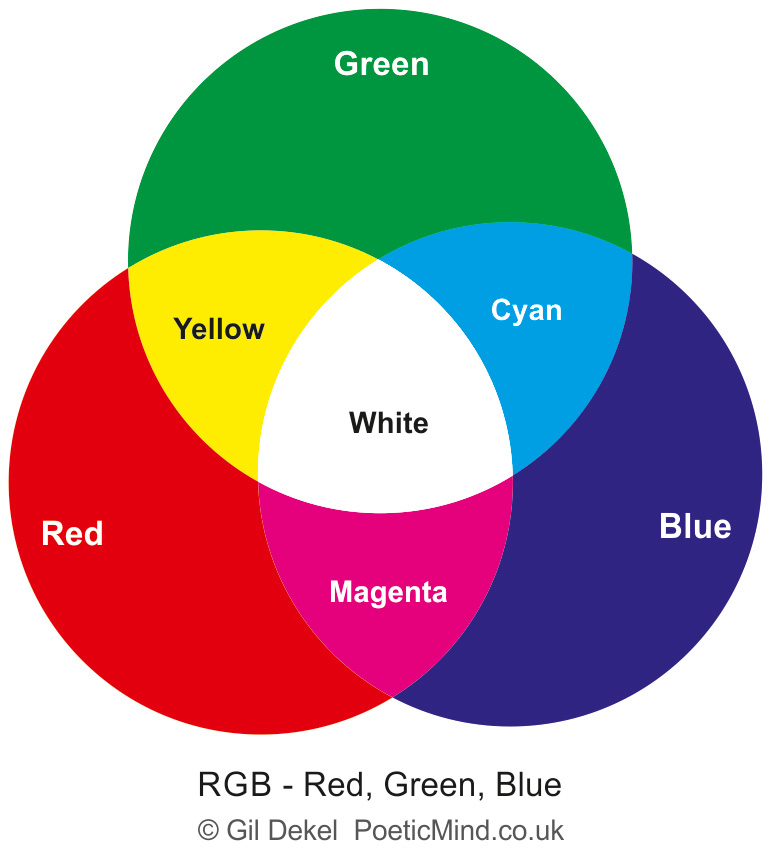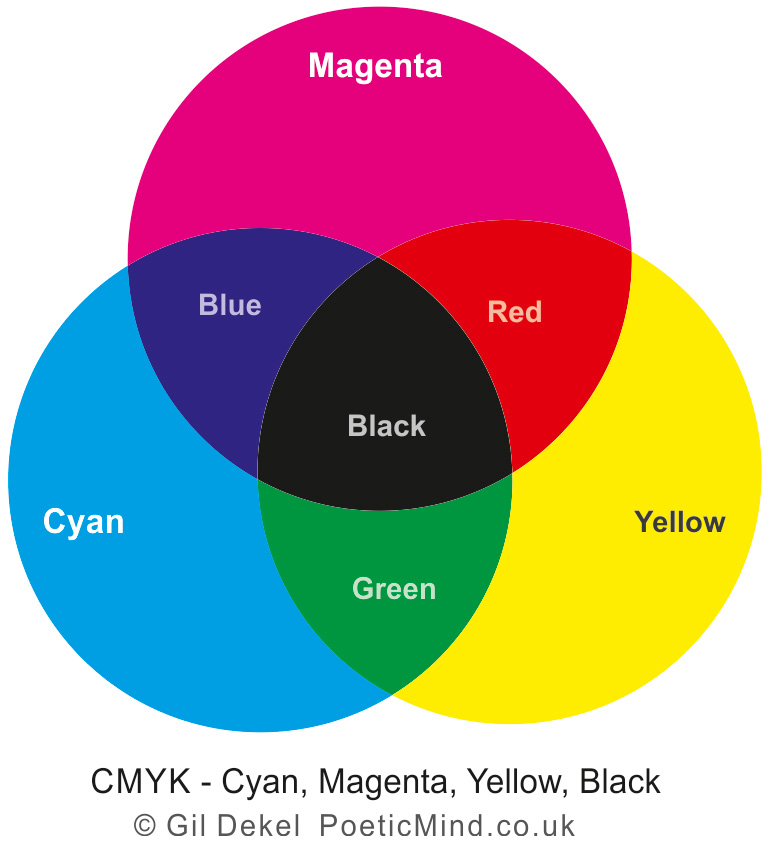By Dr. Gil Dekel. [About]
Colours are made from different light wavelengths. There are a few ways in which light can produce colours.
One way is the RGB system where colours are created electronically on TV and computers screens. RGB is called ‘additive system’.
Another way is the CMYK system. In CMYK some light waves are being absorbed in the colorants (the paints) and some light waves reflect from the colorants. We see only the colours that are reflected. CMYK is a ‘subtractive system’.
RGB model – the additive colour system.
RGB is a method of presenting colours electronically by projecting light rays unto screens, such as TV or computer screens. Each light ray has its unique wavelength that creates a specific colour.
In RGB system we use three basic ‘primary’ colours: red, green, and blue. These colours are being used because they provide the greatest colour gamut once they are combined. We can combine colours in equal amount, or in non-equal amounts, to create new colours.

RGB Colour system. Red, Green and Blue created electronically.
If we combine equal amounts of the primary colours, we produce ‘secondary colours’. For example, equal amounts of red and green will produce the secondary colour yellow. This is why we call the RGB system ‘additive colour system’ – we are adding (combining) colours to create new ones.
Technically the starting point for this system is darkness, i.e. black. For example, when your screen is turned on but the computer is off, then there is no signal coming to the screen. You will see black on your screen. When a signal comes to the screen, colours are projected – red, green or blue, and their combinations which will create other colours.
Lack of light = black.
If we combine equal amounts of primary colours, we create the secondary colours:
Red + green = yellow.
Blue + green = cyan.
Red + blue = magenta.
Red + green + blue = white.
The interesting thing is that the secondary colours – yellow, cyan, and magenta – are the basic colours used in the CMYK model…
CMYK model – the subtractive colour system.
CMYK is a model that presents four basic colours using colorants (such as dyes, inks or paint pigments). The system is used in the printing industry, and by artists that mix paints to paint on canvasses.

The CMYK Colour System – Cyan, Magenta, Yellow and Black colours are created using physical pigments.
The basic colours (pigments) that make this model are Cyan, Magenta, Yellow and Black, in short: CMYK. The letter K represents Black instead of the letter B, because B is already taken to represent Blue in RGB system.
Some theories suggest that K actually stands for the word ‘Key’. Key means outline, i.e. the border around text and images. These borders are usually printed with black colour. In the printing industry it was often easier to start printing the borders, before you go on to print the full colours. So, black is the ‘key’ colour.
CMYK is a subtractive system. The pigments subtract (absorb) some colours from the light, and transmit (reflect) others. We do not see the light waves that are being absorbed. We only see the light waves that are being emitted. For example, light will hit red paint. The red paint will absorb all colours from the light, and will reflect only red light. This is why we will see red colour.
If we mix equal amounts of all there CMY pigments we end up with black colour, because each colour absorbs the light of the other.
In printing we do not use CMY to produce black; rather we use black ink instead.
CMYK colours work like this:
Cyan (a blue-green colour) – absorbs red light, and transmits all other radiations, which we see as cyan colour.
Magenta – absorbs green, and transmits blue and red. Blue and red make magenta.
Yellow – absorbs blue and violet, and transmits only green and red. Green and red create yellow.
The technical starting point in CMYK model is light, which we define as white. As we add paint it then subtracts some wavelengths and emits others. We only see the light emitted from the pigments’ surface.
Look at Photoshop’s Color Balance tool, and you will notice that it corresponds to the CMYK system. The tool was designed to amend images that were then going to print, thus it corresponds to the CMYK system.


So, how do CMYK and RGB differ?
In both CMYK and RGB models we end up seeing the colours that reflect from the object to the human eye. However, there are two main differences:
- RGB colours are more intense than CMYK. Screen colours are created electronically using projected light, which is more vivid than light that bounces off dyes printed on paper. Inks also tend to be absorbed (spread) in the paper and lose their intensity.
- The way that colours are ‘produced’ is different. In RGB we see the colours without any subtraction process. The light rays emit colours unto screens, and we see those colours. As we combine colours, the overlaying process creates new colours.
In CMYK system we also see the emitted colours, yet there was a process of subtraction. Some colours are being absorbed and we do not see them. When we combine colours, the mixing process subtracts colours. We end up seeing only the colours emitted.
Further reading:
colour 2016. Britannica Academic. Retrieved 27 March, 2016, from http://academic.eb.com/EBchecked/topic/126658/colour
Dr. Gil Dekel teaches on the Open University’s Design Thinking course.
© Gil Dekel. 28 March 2016.

the simplest and clearest way to explain the difference between CMYK and RGB.
Thanks.
best, easiest, article explaining RGB and CYMK I have ever seen. Thank you.